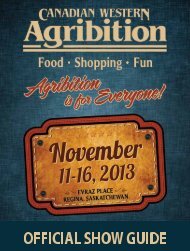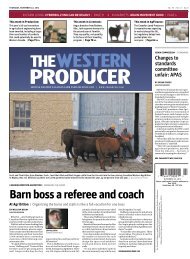You also want an ePaper? Increase the reach of your titles
YUMPU automatically turns print PDFs into web optimized ePapers that Google loves.
LIVESTOCK<br />
LIVESTOCK EDITOR: BARB GLEN | Ph: 403-942-2214 F: 403-942-2405 | E-MAIL: BARB.GLEN@PRODUCER.COM | TWITTER: @BARBGLEN<br />
ALBERTA BEEF PRODUCERS | INQUIRY REQUEST<br />
<strong>Producer</strong>s call<br />
for inquiry<br />
into XL Foods<br />
Looking for answers | <strong>Producer</strong> group wants<br />
to know what caused E. coli contamination<br />
BY BARBARA DUCKWORTH<br />
CALGARY BUREAU<br />
Beef producers want to know what<br />
went wrong at XL Foods following<br />
Canada’s largest ever meat recall.<br />
<strong>The</strong> beef processing company at<br />
Brooks, Alta., was closed for a month<br />
this fall after the discovery of E. coli<br />
0157:H contamination. International<br />
markets were lost, beef from 5,000<br />
head of cattle was destroyed and<br />
questions grew over how things got<br />
out of hand.<br />
Alberta Beef <strong>Producer</strong>s passed a<br />
resolution at its recent annual meeting<br />
calling for an independent inquiry,<br />
and the Canadian Cattlemen’s<br />
Association is demanding answers to<br />
a long list of questions submitted to<br />
the federal government.<br />
“It is a big question everywhere —<br />
what happened?” rancher Bob Lowe<br />
of Nanton said at the ABP meeting<br />
held in Calgary Dec. 3-5.<br />
“It is not a matter of laying blame,”<br />
he said. “We just want answers as to<br />
what happened.”<br />
<strong>The</strong> CCA submitted its questions to<br />
an expert advisory committee within<br />
the federal government.<br />
“We put together a list of 25 questions<br />
based on things like how did the<br />
recall end up getting expanded to<br />
muscle cuts … questions that we<br />
were hearing from producers,” said<br />
CCA vice-president Dave Solverson.<br />
<strong>The</strong>re are also questions about how<br />
communications were handled and<br />
technical matters.<br />
Federal agriculture Gerry Ritz said<br />
in a Dec. 7 interview that the advisory<br />
committee set up to look into the<br />
matter is expected to take months,<br />
said.<br />
He defended the work of the Canadian<br />
Food Inspection Agency and<br />
the extent of the recall.<br />
“We take it to heart and don’t want<br />
to see those types of issues happen<br />
but we will never apologize for the<br />
size and the scope of the recall. If that<br />
is what is required, that is what we<br />
will do,” he said.<br />
He is also confident the management<br />
style of new owners JBS-USA<br />
will introduce a new food safety culture<br />
and new federal legislation for<br />
food safety should improve future<br />
investigations.<br />
In the meantime, XL Foods is processing<br />
up to 2,500 head per day. JBS<br />
has an option to buy the troubled<br />
company and its assets for $100 million<br />
but said it is still evaluating the<br />
deal.<br />
Willie Van Solkema, a former president<br />
of sales and operations at XL<br />
Foods, was named president of JBS-<br />
Canada Dec. 5.<br />
Sterling Fox, head of cattle procurement<br />
for XL, now holds that same job<br />
within the new framework.<br />
“<strong>The</strong>re are a lot of positive things<br />
with JBS coming to Canada,” Fox told<br />
the ABP meeting. “I believe they will<br />
drive a ton of value throughout the<br />
Canadian market.”<br />
As a multinational company, JBS<br />
has a presence in 151 countries and<br />
produces a large portfolio of branded<br />
beef products. XL’s production<br />
should return to 4,000 head per day<br />
once it regains its license to export to<br />
the United States.<br />
“If we had access to beef in the U.S.,<br />
we could be back up to full production,”<br />
Fox said.<br />
Bacterial contamination and food<br />
safety is an ongoing challenge for<br />
large processors.<br />
Scott Entz of Cargill Meat Solutions<br />
of High River, Alta., said the plant<br />
uses practices, training and specific<br />
interventions to reduce contamination<br />
at every step of the process.<br />
“Even at Cargill, I can’t stand up<br />
and tell you we are never ever going<br />
to have microbes,” he said.<br />
“If the loads coming in are high<br />
enough, with all these steps we can’t<br />
guarantee ourselves we have eliminated<br />
all that microbe.”<br />
He said the company conducts<br />
regular staff retraining, particularly<br />
in areas where the risk of contamination<br />
is higher.<br />
It has also installed 120 video cameras<br />
throughout the plant to observe<br />
practices. Employees do not know<br />
when the cameras are photographing<br />
them. Entz said the cameras are<br />
used for training and correcting mistakes<br />
rather than for discipline.<br />
<strong>The</strong> company installed a new<br />
skinning line in 2005, in which carcasses<br />
are washed to remove dirt<br />
and manure before the hide is<br />
removed.<br />
One practice that is not in use is<br />
irradiation. It is approved in the<br />
United States, but Canada does not<br />
allow it. Cargill is working with the<br />
CCA for regulatory change.<br />
However, its use is minimal in the<br />
U.S. because of public perception.<br />
UDDERLY GORGEOUS<br />
TRAILING THE HERD<br />
THE WESTERN PRODUCER | WWW.PRODUCER.COM | DECEMBER 13 , 2012<br />
Calf weight gains are drastically aff ected if cows’<br />
udders aren’t working well. Veterinarian Roy<br />
Lewis gives advice on identifying udder problems<br />
and maintaining udder health. | Page 91<br />
Jeff Taylor follows cows up the coulee on the Flying R Ranch near Elkwater, Alta., just before sunset on Dec. 4.<br />
| CAMILLE REESOR PHOTO<br />
FEED | RESEARCH<br />
Experts working to identify<br />
more feed efficient animals<br />
Looking for savings | <strong>The</strong> rising cost of feeding has officials looking<br />
for genetic markers that could bring savings to producers<br />
BY MARY MACARTHUR<br />
CAMROSE BUREAU<br />
RED DEER — Cattle producers can<br />
save more than $40 per head per year<br />
in feed costs by choosing more feed<br />
efficient animals, says a beef cattle<br />
management specialist.<br />
<strong>The</strong> growing cost of feed grain will<br />
make selecting cattle for feed efficiency<br />
an important tool for producers,<br />
John Basarab told producers<br />
during the <strong>Western</strong> Canadian Grazing<br />
Conference.<br />
“We as a beef industry cannot<br />
ignore that,” said Basarab, a research<br />
scientist with the University of Alberta<br />
and a beef cattle management and<br />
genetics specialist with Alberta Agriculture.<br />
“Inefficient animals eat for fun.”<br />
Basarab has been researching feed<br />
efficiency since the 1990s, but it is<br />
only in recent years, as feed grain<br />
costs rise, that producers and industry<br />
associations have taken a closer<br />
look at selecting feed efficient cattle.<br />
Jeff Hyatt, beef development<br />
co-ordinator with the Canadian<br />
Hereford Association, said the organization<br />
is testing 900 Hereford bulls<br />
over the next three years to identify<br />
the most feed efficient animals.<br />
“We want to identify the most feed<br />
efficient animals within the breed,”<br />
said Hyatt.<br />
<strong>The</strong> association then wants to<br />
develop a marker for the feed efficiency<br />
gene to help identify animals<br />
that have the ability to eat less and<br />
gain the same.<br />
<strong>The</strong> bulls will be tested at Olds College<br />
in Olds, Alta., and Cattleland<br />
Feedyards in Strathmore, Alta., using<br />
the GrowSafe Systems, which can<br />
measure individual feed intake.<br />
Hyatt said finding more efficient<br />
animals is key to keeping the industry<br />
profitable, particularly if producers<br />
can save $40 a head in feed when<br />
only a few years ago profit was $20<br />
per head.<br />
Basarab said feed efficiency is a<br />
moderately inheritable trait. Selecting<br />
for animals that eat less but gain<br />
the same weight seems to have no<br />
affect on growth rate, body size, calving<br />
ease, birth rate and weaning<br />
weight.<br />
Feed costs for slaughter heifers and<br />
steers from efficient sires could be<br />
reduced by $16 a head over a 150-day<br />
finishing period compared to the<br />
offspring of inefficient sires. <strong>The</strong><br />
same 3.7 percent cost saving could<br />
reduce feeding costs for efficient<br />
89<br />
cows by $26 a head compared to inefficient<br />
cows, he added.<br />
Improved feed efficiency will also<br />
help Canadian cattle producers<br />
compete with breeding programs<br />
around the world, which are also<br />
looking at feed efficiency.<br />
“Over the years when I first started,<br />
very few breed associations did this;<br />
now they’re all doing this,” Basarab<br />
said.<br />
“Seed stock producers have already<br />
incorporated this into their breeding<br />
program. All of the beef producing<br />
countries in the world are looking at<br />
it very seriously. All they’re figuring<br />
out is how to include it into a multitrait<br />
selection program.”<br />
<strong>The</strong> chicken, dairy and pork sectors<br />
have already developed animals with<br />
better feed efficiency, he added.<br />
“<strong>The</strong>y’ve blown our socks off.”<br />
Basarab estimates a five percent<br />
increase in feed efficiency would<br />
mean $100 million in savings, even if<br />
it were adopted by only 30 percent of<br />
cattle producers.<br />
He said rotational grazing, cross<br />
breeding, improved management<br />
and genetic selection have all<br />
improved efficiency in cattle. <strong>The</strong><br />
next step is choosing cattle that eat<br />
less.








